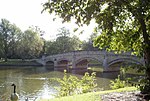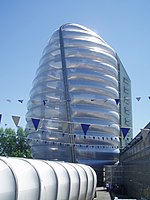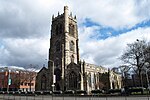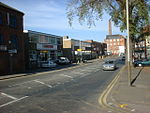Leicester Abbey

The Abbey of Saint Mary de Pratis, more commonly known as Leicester Abbey, was an Augustinian religious house in the city of Leicester, in the East Midlands of England. The abbey was founded in the 12th century by the Robert de Beaumont, 2nd Earl of Leicester, and grew to become the wealthiest religious establishment within Leicestershire. Through patronage and donations the abbey gained the advowsons of countless churches throughout England, and acquired a considerable amount of land, and several manorial lordships. Leicester Abbey also maintained a cell (a small dependent daughter house) at Cockerham Priory, in Lancashire. The Abbey's prosperity was boosted through the passage of special privileges by both the English Kings and the Pope. These included an exemption from sending representatives to parliament and from paying tithe on certain land and livestock. Despite its privileges and sizeable landed estates, from the late 14th century the abbey began to suffer financially and was forced to lease out its estates. The worsening financial situation was exacerbated throughout the 15th century and early 16th century by a series of incompetent, corrupt and extravagant abbots. By 1535 the abbey's considerable income was exceeded by even more considerable debts. The abbey provided a home to an average of 30 to 40 canons, sometimes known as Black Canons, because of their dress (a white habit and black cloak). One of these canons, Henry Knighton, is notable for his Chronicle, which was written during his time at the abbey in the 14th century. In 1530 Cardinal Thomas Wolsey died at the abbey, whilst travelling south to face trial for treason. A few years later, in 1538, the abbey was dissolved, and was quickly demolished, with the building materials reused in various structures across Leicester, including a mansion which was built on the site. The house passed through several aristocratic families, and became known as Cavendish House after it was acquired by the 1st Earl of Devonshire, in 1613. The house was eventually looted and destroyed by fire in 1645, following the capture of Leicester during the English Civil War. Part of the former abbey precinct was donated to Leicester Town Council (the predecessor of the modern City Council) by the 8th Earl of Dysart. In 1882 it was opened by The Prince of Wales and became known as Abbey Park. The remaining 32 acres (13 ha), which included the abbey's site and the ruins of Cavendish House, were donated to the council by the 9th Earl of Dysart in 1925 and, following archaeological excavations, opened to the public in the 1930s. Following its demolition, the exact location of the abbey was lost; it was only rediscovered during excavations in the 1920s/30s, when the layout was plotted using low stone walls. The abbey has been extensively excavated and was previously used for training archaeology students at the University of Leicester. Leicester Abbey is now protected as a scheduled monument and is Grade I Listed.
Excerpt from the Wikipedia article Leicester Abbey (License: CC BY-SA 3.0, Authors, Images).Leicester Abbey
Abbey Park Road, Leicester Stocking Farm
Geographical coordinates (GPS) Address External links Nearby Places Show on map
Geographical coordinates (GPS)
| Latitude | Longitude |
|---|---|
| N 52.648948 ° | E -1.13687 ° |
Address
Leicester Abbey (Abbey of Saint Mary de Pratis)
Abbey Park Road
LE4 5AP Leicester, Stocking Farm
England, United Kingdom
Open on Google Maps









